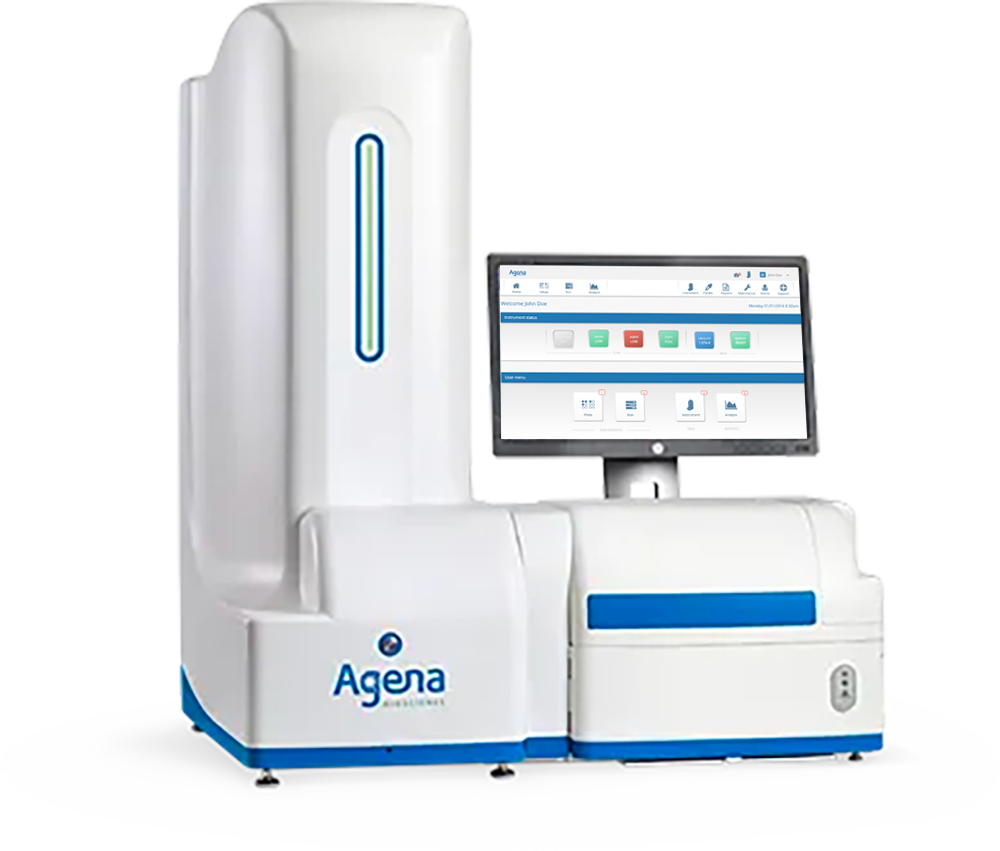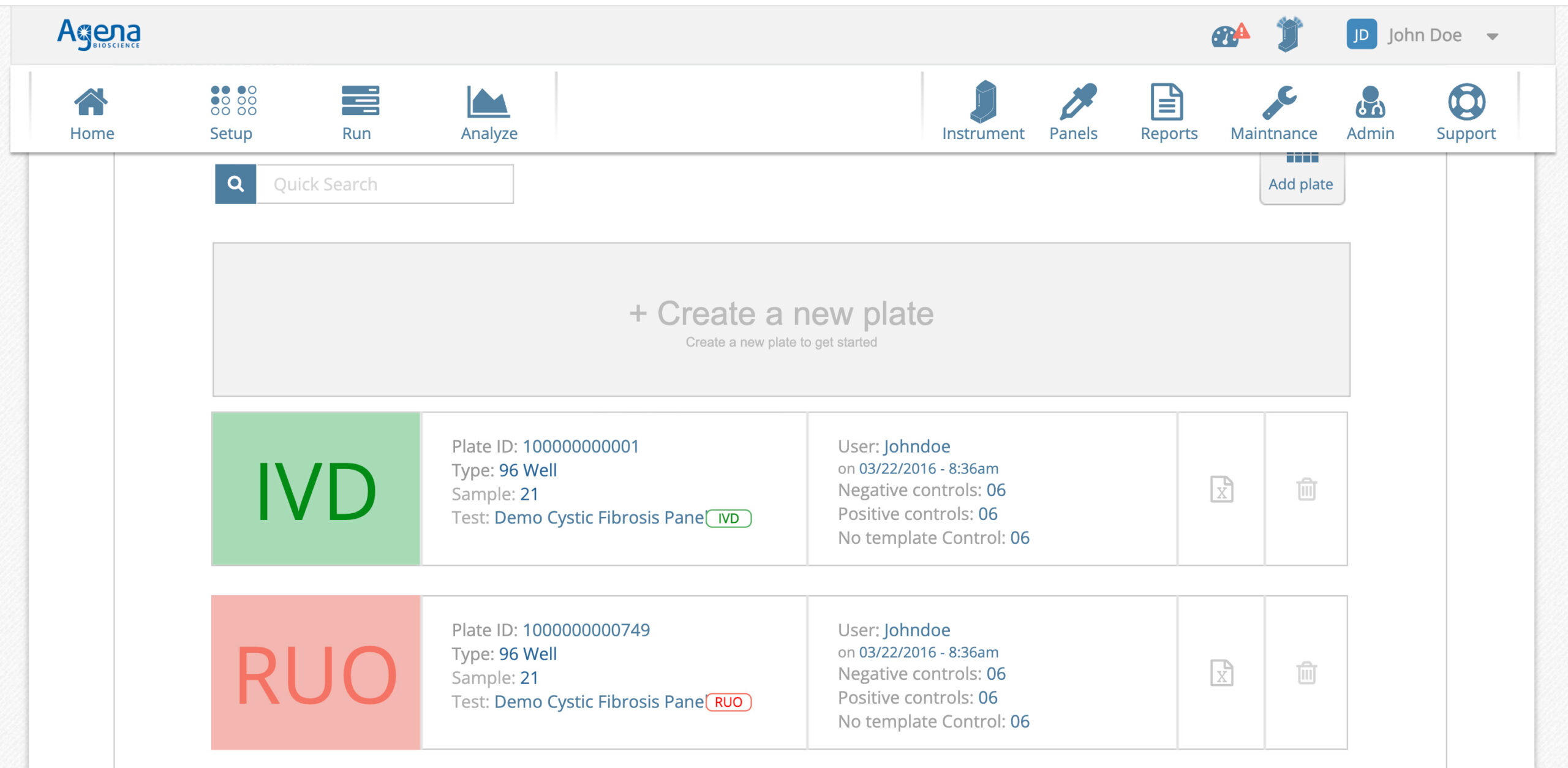AGENA BIOSCIENCE
DNA Mass Assay Analyzer
At Agena Bioscience, a leading bioscience company, I served as the Senior Head UI/UX Designer and Strategist. I was instrumental in the development of a DNA Mass Array Analyzer application, a complex platform designed to monitor various Key Performance Indicators (KPIs) for both the instrument and the operator. The application featured dashboards for overall health, run specifics, and setup configurations, among other functionalities like real-time notifications and error handling.
Goal #1
AGENA-BIO
Transforming DNA Analysis Through Intuitive Design and Precision Analytics.
At Agena Bioscience, I served as the Senior Head UI/UX Designer and Strategist, leading the development of a comprehensive DNA Mass Array Analyzer application. My role encompassed everything from initial research and design to end-to-end prototyping and validation. I collaborated closely with operators and stakeholders to optimize user experience, while also ensuring compliance with FDA and ISO standards. The application became a key asset in securing the company’s next round of funding.
Goal
To develop a user-centric and compliant DNA Mass Array Analyzer application that would serve as a pivotal asset for Agena Bioscience and aid in securing the next round of funding.
Challenge
Navigating the complexities of integrating a highly sensitive hardware system with a user-friendly UI, all while adhering to FDA and ISO compliance standards. This was particularly challenging given that this was an emerging technology with few precedents.
Approach
Utilized an end-to-end strategy that began with comprehensive research and extended through design, prototyping, and validation. Engaged in close collaboration with operators, stakeholders, and compliance experts to ensure the application met both user needs and regulatory requirements. The successful prototype became a key asset in securing the company’s next round of funding.
My Role
- Led the development of a comprehensive DNA Mass Array Analyzer application.
- Conducted initial research to understand user needs and technical requirements.
- Designed end-to-end prototypes, focusing on user experience and interface design.
- Validated prototypes through usability testing and operator feedback.
- Collaborated closely with developers for seamless implementation of design elements.
- Utilized a range of technologies and tools, including Bootstrap, HTML5, CSS3, AngularJS, and various design software.
- Ensured compliance with FDA and ISO standards, navigating complex regulatory landscapes.
- Managed sensitive hardware integration with the user interface, pioneering in an emerging technology field.
- Played a key role in securing the company’s next round of funding by demonstrating the application’s potential through the prototype.
- Engaged with stakeholders and company SEO to align project goals and secure investment.
- Oversaw journey mapping and sprint planning to align development efforts with user needs and business objectives.
- Contributed to custom UI libraries and documentation for future development efforts.
- Assisted in writing support documentation to facilitate user understanding and technical troubleshooting.

Achievements:
-
Successfully led the design and development of a pioneering DNA Mass Array Analyzer application, setting a new standard in the field.
-
Played a pivotal role in securing the company’s next round of funding by showcasing the application’s potential and future direction through a well-crafted prototype.
-
Achieved full compliance with FDA and ISO standards, mitigating risks and ensuring the application met all regulatory requirements.
-
Spearheaded the integration of highly sensitive hardware with a user-friendly UI, marking a first in this emerging technology sector.
-
Conducted successful usability tests and validations, resulting in a user-centric application that met both operator and stakeholder needs.
-
Established a robust collaboration framework that involved developers, operators, stakeholders, and company SEO, ensuring alignment across all project phases.
-
Created custom UI libraries and comprehensive support documentation, laying the groundwork for future development and user support.
-
Managed to deliver a pixel-perfect, fully functional application on time, meeting all project milestones and objectives.
-
Introduced journey mapping and sprint planning methodologies, optimizing the development process and aligning it more closely with user needs and business goals.
-
Received positive feedback from both users and stakeholders, affirming the application’s usability, functionality, and compliance standards.

The Approach:
Initial Research
- Conduct comprehensive research
- Understand technical requirements, user needs, and regulatory landscape
- Lay the foundation for the entire project
Prototyping
- Design end-to-end prototypes
- Focus on user experience, interface design, and hardware integration
- Utilize tools like Bootstrap, HTML5, CSS3, and AngularJS
Validation
- Conduct usability tests
- Gather operator feedback
- Make adjustments based on insights for a user-centric design
Collaboration
- Assemble a multidisciplinary team
- Include developers, operators, stakeholders, and company SEO
- Ensure seamless implementation and alignment with project goals
Compliance Assurance
- Engage with compliance experts
- Ensure application meets FDA and ISO standards
- Address the sensitive nature of the hardware and emerging technology
Hardware Integration
- Manage the integration of highly sensitive hardware with the user interface
- Pioneering effort in this emerging field
Funding Strategy
- Utilize the prototype to demonstrate application’s potential
- Secure the next round of funding
Documentation and Libraries
- Contribute to custom UI libraries
- Write comprehensive support documentation
Project Management
- Employ journey mapping and sprint planning methodologies
- Keep the development process organized and aligned with user needs and business objectives
Final Delivery
- Ensure delivery of a fully functional application
- Meet all project milestones, user needs, and compliance requirements
Special Focus Areas
Understanding DNA Structure
- Integrate modules for DNA structure analysis
- Enhance the application’s capabilities in the biotech field
Mass Array Machine Laser Tip
- Investigate what is really inside the tip of the laser
- Add a layer of innovation and complexity to the project

Strategy:
Phase 1: Research and Planning
Objectives:
- Conduct initial research to understand the landscape
- Develop a project plan
Key Activities:
- Comprehensive research on technical requirements, user needs, and regulations
- Draft a project timeline and allocate resources
Deliverables:
- Research report
- Project plan and timeline
Phase 2: Prototyping and Design
Objectives:
- Create prototypes based on research
- Design the user interface
Key Activities:
- Develop end-to-end prototypes
- Utilize design tools like Bootstrap, HTML5, CSS3, and AngularJS
Deliverables:
- Functional prototypes
- Design mockups
Phase 3: Validation and Feedback
Objectives:
- Validate the prototypes
- Collect user feedback
Key Activities:
- Conduct usability tests
- Gather operator and stakeholder feedback
Deliverables:
- Usability report
- Feedback summary
Phase 4: Development and Collaboration
Objectives:
- Develop the application
- Foster team collaboration
Key Activities:
- Code development
- Regular team meetings and updates
Deliverables:
- Beta version of the application
- Collaboration report
Phase 5: Compliance and Integration
Objectives:
- Ensure regulatory compliance
- Integrate hardware
Key Activities:
- Consult with compliance experts
- Hardware-software integration
Deliverables:
- Compliance certificates
- Integrated application
Phase 6: Funding and Documentation
Objectives:
- Secure additional funding
- Document the project
Key Activities:
- Present the prototype to potential investors
- Write comprehensive documentation
Deliverables:
- Funding secured
- Documentation and libraries
Phase 7: Final Delivery and Special Focus
Objectives:
- Finalize the application
- Special focus on DNA structure and Mass Array machine laser tip
Key Activities:
- Final testing and quality assurance
- Research on DNA structure and laser tip technology
Deliverables:
- Fully functional application
- Special focus report

Key Metrics:
-
Number of Research Sources Consulted: Measures the depth of initial research.
-
Time to Complete Initial Research: Indicates efficiency in the planning phase.
-
Percentage of Project Milestones Defined: Gauges the clarity of project objectives.
-
Number of Prototypes Created: Assesses the extent of design exploration.
-
User Engagement on Prototypes: Measures user interaction, such as click-through rates.
-
Time Spent on Design Iterations: Indicates the speed of design improvements.
-
Number of Usability Tests Conducted: Measures the thoroughness of the validation phase.
-
User Satisfaction Score: Gauges user contentment with the prototype.
-
Number of Actionable Feedback Points: Indicates the quality of feedback received.
-
Number of Development Sprints Completed: Measures development progress.
-
Team Collaboration Score: Assesses the effectiveness of team interactions.
-
Code Quality Metrics: Such as bugs per lines of code, to gauge development quality.
-
Number of Compliance Checkpoints Passed: Measures success in meeting regulatory standards.
-
Time for Hardware-Software Integration: Indicates efficiency in integration.
-
Number of Integration Issues Resolved: Measures problem-solving capability.
-
Amount of Funding Secured: Indicates success in attracting investment.
-
Number of Documentation Pages Created: Measures the extent of project documentation.
-
Time to Complete Documentation: Indicates efficiency in wrapping up the project.
-
Number of Project Milestones Met: Measures overall project success.
-
Final User Satisfaction Score: Gauges end-user contentment with the final product.
-
Special Focus Research Impact: Such as citations or references, to measure the impact of special focus areas like DNA structure and Mass Array machine laser tip technology.

Key Learnings and Takeaways:
-
Importance of Initial Research: Comprehensive research at the outset can significantly influence the project’s direction and success.
-
User-Centric Design: Focusing on user experience from the prototyping phase leads to higher user satisfaction.
-
Value of Validation: Usability tests and operator feedback are crucial for refining the product.
-
Team Collaboration: A multidisciplinary team can provide diverse insights, leading to a more robust end product.
-
Regulatory Compliance: Early engagement with compliance experts can save time and resources in later stages.
-
Hardware-Software Integration: This is a complex but necessary process, especially for projects involving sensitive or specialized hardware.
-
Funding Strategy: A well-executed prototype can be a powerful tool for securing additional funding.
-
Documentation: Comprehensive documentation not only serves as a project archive but also facilitates future development.
-
Project Management: Employing structured methodologies like journey mapping and sprint planning helps keep the project on track.
-
Special Focus Areas: Researching niche areas like DNA structure and Mass Array machine laser tip technology can add significant value to the project.
-
Agility in Execution: Being flexible and ready to pivot is essential, especially when dealing with emerging technologies.
-
Quality Over Speed: Meeting all milestones is important, but not at the expense of quality.
-
Feedback Loop: Continuous feedback, both internal and external, is invaluable for ongoing improvement.
-
Risk Management: Identifying and mitigating risks early can prevent costly issues later on.
-
Resource Allocation: Efficient use of resources, both human and material, is crucial for staying within budget and timeline.
-
End-User Satisfaction: Ultimately, the project’s success is measured by the satisfaction of the end-users.

Next Steps:
-
Post-Project Evaluation: Conduct a thorough review of the project to identify successes and areas for improvement.
-
Stakeholder Debrief: Present key findings, learnings, and outcomes to stakeholders.
-
User Training: Implement training programs to help end-users adapt to the new application.
-
Rollout Strategy: Develop and execute a phased rollout plan for the application.
-
Ongoing Support: Establish a support team to handle queries and issues post-launch.
-
Performance Monitoring: Set up tools and KPIs to continuously monitor the application’s performance.
-
User Feedback Loop: Create channels for collecting ongoing user feedback for future refinements.
-
Software Updates: Plan and schedule regular updates to the application based on user feedback and technological advancements.
-
Compliance Updates: Keep an eye on regulatory changes that might require adjustments to the application.
-
Financial Review: Conduct a financial analysis to measure ROI and other key financial metrics.
-
Knowledge Transfer: Ensure that all project documentation and learnings are transferred to the relevant departments.
-
Future Funding: Explore opportunities for additional funding for next-phase developments or new projects.
-
Market Expansion: Research potential markets or sectors where the application could be introduced.
-
Technology Watch: Keep abreast of emerging technologies that could be integrated into future versions of the application.
-
Team Recognition: Acknowledge and reward the project team for their hard work and achievements.
-
Project Archive: Archive all project materials in an organized manner for future reference.
-
Next Project Planning: Based on the learnings and successes of this project, begin planning the next project.
